
The "Dams Raid"
On May 16-17, 1943, the Lancaster crews of 617 Squadron demonstrated unflinching courage in the execution of an ambitious and highly dangerous feat of arms, utilizing a new and operationally untested weapon and establishing a legend that still resonates today. The Dams Raid had an impact totally out of proportion to the small number of aircraft involved and heralded a new era of precision bombing.
Operation Chastise was a success in so far as the Möhne and Eder dams were both breached, although overshadowing that success and the publicity and legendary status awarded to it ever since is the tragedy that 56 of the 133 airmen who set out on the mission did not return. However, the amazing technical ingenuity at the heart of the raid, and the skill and courage of the airmen of 617 Squadron, were not in vain. The cost to the Germans of repairing the damage wrought by the raid was enormous-psychologically, materially, logistically and financially-and it was one that they simply could not afford. One of those killed in action that night was Flight Lieutenant John "Hoppy" Hopgood, DFC and Bar.
Pilot John Hopgood
John Vere Hopgood joined the RAF in August 1940 when he was 18. He qualified as a pilot in February 1941 and was then commissioned. After completing further training, and still only 19 years old, he joined 50 Squadron, flying Handley Page Hampdens on his first tour of operations as a bomber pilot. He was then posted to a training unit as an instructor.
In February 1942 he returned to operational flying with 106 Squadron, which was based at RAF Coningsby, in Lincolnshire, England, flying the unreliable and underpowered twin-engine Avro Manchester. Hopgood flew 11 "ops" on Manchesters before the squadron began to receive new Avro Lancasters, and he became one of the first pilots to convert to the new four-engine aircraft.
Denne historien er fra May - June 2023-utgaven av Flight Journal.
Start din 7-dagers gratis prøveperiode på Magzter GOLD for å få tilgang til tusenvis av utvalgte premiumhistorier og 9000+ magasiner og aviser.
Allerede abonnent ? Logg på
Denne historien er fra May - June 2023-utgaven av Flight Journal.
Start din 7-dagers gratis prøveperiode på Magzter GOLD for å få tilgang til tusenvis av utvalgte premiumhistorier og 9000+ magasiner og aviser.
Allerede abonnent? Logg på

Keeping 'em Flying!- The new generation of warbird pilots, restorers and mechanics
The new generation of warbird pilots, restorers and mechanics. Nearly 80 years after the end of World War II, the fighters, bombers, and trainers that defended freedom continue to enthrall and inspire audiences at airshows, thanks to generations of warbird pilots, maintainers, restoration specialists and collectors. In our September, 2022 issue we introduced you to the young warbird pilots, maintainers and restorers who are already beginning to displace more "experienced" warbird fliers and fixers.

The Corsair Maker- Bringing the Vought Corsair to the fleet was a daunting challenge that spanned nearly three years.
When the first production Corsairs exited the Stratford factory in June 1942, Guyton, as seen here, was tapped to manage the flight and production test program. Armament was improved to six wing-mounted .50s, displacing the wing fuel tanks now placed forward of the cockpit which necessarily was moved rearward by 32 inches. Overall length was increased, armor plate added, landing, arresting and tail gear improved, aileron control enhanced, and a new version of the R2800 engine was incorporated. But those significant improvements unearthed numerous idiosyncrasies that would take an extended period to make the Corsair acceptable for carrier operations
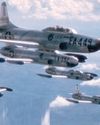
STARFIRES Over Korea
F-94 pilots tangle with MiGs
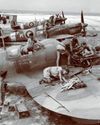
Training Mission
BY THE TIME THIS TRAINING SCENE WAS RECORDED in Canne, Italy, in July 1944, Allied Yugoslavian airmen had several years of experience working side by side with the RAF.
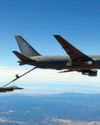
KC-46A PEGASUS
Next generation aerial refueler
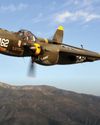
"SATAN'S ANGELS" ACE - Tales from a P-38 pilot in the South Pacific
\"AS A KID GROWING UP on the bow of my father's tugboat, hauling oil from Seattle to Alaska, I had a lot of time on my hands.
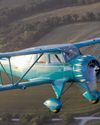
WACO YKC - Stunning and Ultra Rare Golden Age Cabin Flier
BETWEEN THE IMPLEMENTATION of the Air Commerce Act of 1926 and December 31, 1948, all U.S. registered flying machines sported an N-number, much as they do today, the \"N\" being an internationally recognized identifier for the United States. During that period, however, an additional letter-identifier followed the \"N.\" Depending on their category, they were registered in the NC (Commercial), NG (Glider), NL (Limited), NR (Restricted, usually meaning race airplanes), NS (State government), and, finally, NX (experimental).
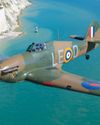
BADER'S HURRICANES
Double amputee fighter ace Douglas Bader and his Battle of Britain Hurricanes
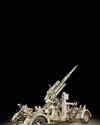
Scourge of the Allied Fighters
IT HAD TO BE THE MOST HELPLESS FEELING in the world: you're at 25,000 feet over Europe knowing that your primary function is to drop bombs-or flying escort for the bombers while being a slow-moving target for some of the world's finest shooters. However, you have John Browning's marvelous .50 caliber invention to give some degree of protection. Unfortunately, you're absolutely helpless against flak. Piloting and gunnery skills play no role in a game where sheer chance makes life and death decisions. For that reason, the Krupp 88 mm Flak 18/36/37 AA cannon could be considered WW II's ultimate stealth fighter. You never saw it coming.
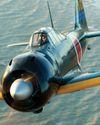
ZERO MYTH, MYSTERY, AND FACT
A test pilot compares the A6M5 Zero to U.S. fighters